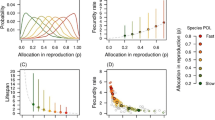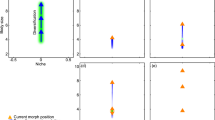Abstract
Successive generations of bi- and multivoltine species encounter differing biotic and abiotic environments intra-annually. The question of whether selection can independently adjust the relationship between body size and components of reproductive effort within successive generations in response to generation-specific environmental variation is applicable to a diversity of taxa. Herein, we develop a conceptual framework that illustrates increasingly independent life history adjustments between successive generations of taxa exhibiting complex life cycles. We apply this framework to the reproductive biology of the gall-forming insect, Belonocnema treatae (Hymenoptera: Cynipidae). This bivoltine species expresses cyclical parthenogenesis in which alternating sexual and asexual generations develop in different seasons and different environments. We tested the hypotheses that ecological divergence between the alternate generations is accompanied by generational differences in body size, egg size, and egg number and by changes in the relationships between body size and these components of reproductive effort. Increased potential reproductive effort of sexual generation B. treatae is attained by increased body size and egg number (with no trade-off between egg number and egg size) and by a significant increase in the slope of the relationship between body size and potential fecundity. These generation-specific relationships, interpreted in the context of the model framework, suggest that within each generation selection has independently molded the relationships relating body size to potential fecundity and potential reproductive effort in B. treatae. The conceptual framework is broadly applicable to comparisons involving the alternating generations of bi- and multivoltine species.



Similar content being viewed by others
References
Askew RR (1984) The biology of gall wasps. In: Anantakrishnan TN (ed) The biology of galling insects. Edward Arnold, London, pp 223–271
Ayabe Y, Minoura T, Hijii N (2015) Plasticity in resource use by the leafminer moth Phyllocnistis sp. in response to variations in host plant resources over space and time. J For Res 20:213–221. doi:10.1007/s10310-014-0467-9
Bell G (1982) The masterpiece of nature: the evolution and genetics of sexuality. University of California Press, Berkeley
Berger D, Walter R, Gotthard K (2008) What limits insect fecundity? Body size-and temperature-dependent egg maturation and oviposition in a butterfly. Funct Ecol 22:523–529. doi:10.1111/j.1365-2435.2008.01392.x
Berger D, Olofsson M, Friberg M, Karisson B, Wiklund C, Gotthard K, Gilburn A (2012) Intraspecific variation in body size and the rate of reproduction in female insects: adaptive allometry or biophysical constraint? J Anim Ecol 16:1244–1258. doi:10.1111/j.1365-2656.2012.02010.x
Brisson JA, Stern DL (2006) The pea aphid, Acythosiphon pisum: an emerging economic model system for ecological, developmental and evolutionary studies. BioEssays 28:747–755. doi:10.1002/bies.20436
Brown JM, Abrahamson WG, Packer RA, Way PA (1995) The role of natural-enemy escape in a gallmaker host-plant shift. Oecologia 1:52–60. doi:10.1007/BF00365562
Darwin CR (1874) The descent of man, and selection in relation to sex. John Murray, London
Ebenman B (1992) Evolution in organisms that change their niches during the life cycle. Am Nat 139:900–1021. doi:10.1086/285370
Egan SP, Ott JR (2007) Host plant quality and local adaptation determine the distribution of a gall-forming herbivore. Ecology 88:2868–2879. doi:10.1890/06-1303.1
Egan SP, Hood GR, Feder JL, Ott JR (2012) Divergent host plant use promotes reproductive isolation among cynipid gall wasp populations. Biol Lett 8:605–608. doi:10.1098/rsbl.2011.1205
Egan SP, Hood GR, DeVela G, Ott JR (2013) Parallel patterns of morphological and behavioral variation among host-associated populations of two gall wasp species. PLoS ONE 8:e54960. doi:10.1371/journal.pone.0054690
Eliason EA, Potter DA (2000) Biology of Callirhytis cornigera (Hymenoptera: Cynipidae) and the arthropod community inhabiting its galls. Environ Entomol 29:551–559. doi:10.1603/0046-225X-29.3.551
Feder JL (1995) The effects of parasitoids on sympatric host races of Rhagoletis pomonella (Diptera: Tephritidae). Ecology 76:801–813. doi:10.2307/1939346
Folliot R (1964) Contribution a l’etude de la biologie des cynipides galliocoles (Hymenoptera: Cynipoidea). Ann Sci Nat Zool Paris 12:407–564
Forbes AA, Hall MC, Lund J, Hood GR, Izen R, Egan SP, Ott JR (2015) Parasitoids, hyperparasitoids and inquilines associated with the sexual and asexual generations of the gall former Belonocnema treatae (Hymenoptera: Cynipidae). Ann Entoml Soc Am 109:49–63. doi:10.1093/aesa/sav112
Fox CW, Czesak ME (2000) Evolutionary ecology of progeny size in arthropods. Annu Rev Entomol 45:341–369. doi:10.1146/annurev.ento.45.1.341
Galaktionov KV, Dobrovolskij A (2004) The biology and evolution of trematodes: an essay on the biology, morphology, life cycles, transmissions, and evolution of digenetic trematodes. Springer, New York
Graziosi I, Rieske L (2014) Potential fecundity of a highly invasive gall maker, Dryocosmus kuriphilus (Hymenoptera: Cynipidae). Environ Entomol 43:1053–1058. doi:10.1603/EN14047
Hebert PDN (1987) Genotypic characteristics of cyclic parthenogenesis and their obligately asexual derivatives. In: Stearns PC (ed) The evolution of sex and its consequences. Birkhauser-Verlag, Basel, pp 175–218
Hernandez CE, Rodriguez-Serrano E, Avaria-Llautureo J, Inostroza-Michael O, Morales-Pallero B, Boric-Bargetto D, Canales-Aguirre CB, Marquet PA, Meade A (2013) Using phylogenetic information and the comparative method to evaluate hypotheses in marcoecology. Methods Ecol Evol 4:401–415. doi:10.1111/2041-210X.12033
Honek A (1993) Intraspecific variation in body size and fecundity in insects: a general relationship. Oikos 66:483–492. doi:10.2307/3544943
Hood GR, Ott JR (2010) Developmental plasticity and reduced susceptibility to natural enemies following host plant defoliation in a specialized herbivore. Oecologia 162:673–683. doi:10.1007/s00442-009-1492-9
Hood GR, Ott JR (2011) Generational shape shifting: changes in egg shape and size between sexual and asexual generations of a cyclically parthenogenic gall former. Entomol Exp Appl 141:88–96. doi:10.1111/j1570-7458.2011.01169.x
Ide T, Wachi N, Abe Y (2010) Discovery of a new Plagiotrochus species (Hymenoptera: Cynipidae) inducing galls on the evergreen oak in Japan. Ann Entomol Soc Am 6:838–843. doi:10.1603/AN10101
Ishihara M (1999) Adaptive phenotypic plasticity and its difference between univoltine and multivoltine populations in a bruchid beetle, Kytorhinus sharpianus. Evolution 53:1979–1986. doi:10.2307/2640457
Istock CA (1967) The evolution of complex life cycle phenomena: an ecological perspective. Evolution 21:592–605. doi:10.2307/2406619
Jervis MA, Ellers J, Harvey JA (2008) Resource acquisition, allocation, and utilization in parasitoid reproductive strategies. Ann Rev Entomol 53:361–385. doi:10.1146/annurev.ento.53.103106.093433
Kenkel NC, Juhasz-Nagy P, Podani J (1989) On sampling procedures in population and community ecology. Vegetatio 83:195–207. doi:10.1007/BF00031692
Kivela SM, Valimaki P, Gotthard K (2013) Seasonality maintains alternative life history phenotypes. Evolution 67:3145–3160. doi:10.1111/evo.12181
Leather SR (1988) Size, reproductive potential and fecundity in insects: things aren’t as simple as they seem. Oikos 51:386–389. doi:10.2307/3565323
Lund JN, Ott JR, Lyons R (1998) Heterogony in Belonocnema treatae Mayr (Hymenoptera: Cynipidae). Proc Entomol Soc Wash 100:755–763
Mank JE (2017) The transcriptional architecture of phenotypic dimorphism. Nat Ecol Evol 1:006. doi:10.1038/s41559-016-0006
Manousaki T et al (2013) Parsing parallel evolution: ecological divergence and differential gene expression in the adaptive radiations of thick-lipped Midas cichlid fishes from Nicaragua. Mol Ecol 22:650–669. doi:10.1111/mec.12034
Maynard Smith J (1978) The evolution of sex. Cambridge University Press, Cambridge
Minelli A, Fusco G (2010) Developmental plasticity and the evolution of animal complex life cycles. Philos Trans R Soc B 365:631–640. doi:10.1098/rstb.2009.0268
Moran NA (1992) The evolutionary maintenance of alternative phenotypes. Am Nat 139:971–989. doi:10.1086/285369
Moran NA (1994) Adaptation and constraint in the complex life cycles of animals. Annu Rev Ecol Syst 25:573–600. doi:10.1146/annurev.es.25.110194/003041
Muller CH (1961) The live oaks of the series Virentes. Am Midl Nat 65:17–39. doi:10.2307/2422999
Normark BB (2003) The evolution of alternative genetic systems in insects. Annu Rev Entomol 48:397–423. doi:10.1146/annurev.ento.48.091801.112703
Pigliucci M (2005) Evolution of phenotypic plasticity: where are we going now? Trends Ecol Evol 20:481–486. doi:10.1016/j.tree.2005.06.001
Preziosi RF, Fairbairn DJ, Roff DA, Brennan JM (1996) Body size and fecundity in the waterstrider Aquarius remigis: a test of Darwin’s fecundity advantage hypothesis. Oecologia 108:424–431. doi:10.1007/BF00333717
Pujade-Villar J, Bellido D, Segu G, Melika G (2001) Current state of knowledge of heterogony in Cynipidae (Hymenoptera, Cynipoidea). Sess Conjunta dEntomol 11:87–107
R Core Team (2014) R: a language and environment for statistical computing. R Foundation for Statistical Computing, Vienna
Roff DA (2002) Life history evolution. Sinauer Associates Inc, Sunderland
Rogers LE, Hinds WT, Buschbom RL (1976) A general weight vs. length relationship for insects. Ann Entomol Soc Am 69:387–389. doi:10.1093/aesa/69.2.387
Rokas A, Melika G, Abe Y, Nieves-Aldrey JL, Cook JM, Stone GN (2003) Lifecycle closure, lineage sorting, and hybridization revealed in a phylogenetic analysis of European oak gallwasps (Hymenoptera: Cynipidae: Cynipini) using mitochondrial sequencing data. Mol Phylogenet Evol 26:36–45. doi:10.1016/S1055-7903(02)00329-9
Schonrogge K, Harper LJ, Lichtenstein CP (2000) The protein content of tissue in cynipid galls (Hymenoptera: Cynipidae): similarities between cynipid galls and seeds. Plant, Cell Environ 23:215–222. doi:10.1046/j.1365-3040.2000.00543.x
Schroder T, Gilbert JJ (2004) Transgenerational plasticity for sexual reproduction and diapause in the life cycle of monogonont rotifers: intraclonal, intraspecific and interspecific variation in the response to crowding. Funct Ecol 18:458–466. doi:10.1111/j.0269-8463.2004.00854.x
Simon JC, Rispe C, Sunnucks P (2002) Ecology and evolution of sex in aphids. Trends Ecol Evol 17:34–39. doi:10.1016/S0169-5347(01)02331-X
Slade NA, Wassersug RJ (1975) On the evolution of complex life cycles. Evolution 29:568–571. doi:10.2307/2407267
Smith CC, Fretwell SD (1974) The optimal balance between size and number of offspring. Am Nat 108:499–506. doi:10.1086/282929
Sokal RR, Rohlf FJ (2012) Biometry, the principles and practice of statistics in biological research, 4th edn. Freeman and Co., New York
Stearns SC (1992) The evolution of life histories. Oxford University Press, Oxford
Stollewerk A (2010) The water flea Daphnia: a ‘new’ model system for ecology and evolution? J Biol 9:21. doi:10.1186/jbiol212
Stone GN, Schronrogge K, Atkinson RJ, Bellido D, Pujade-Villar J (2002) The population biology of oak gall wasps (Hymenoptera: Cynipidae). Annu Rev Entomol 47:633–668. doi:10.1146/annurev.ento.47.091201.145247
Visser B, Dooremalen CV, Ruiz AV, Ellers J (2013) Fatty acid composition remains stable across trophic levels in a gall wasp community. Physiol Entomol 38:306–312. doi:10.1111/phen.12035
Wachi N, Abe Y (2010) Taxonomic status of the oak gall wasp Callirhytis hakonensis (Hymenoptera: Cynipidae), with description of the sexual generation. Ann Entomol Soc Am 103:322–326. doi:10.1603/AN09128
Werner EE (1988) Size, scaling and the evolution of complex life cycles. In: Ebenman B, Persson L (eds) Size-structured populations. Springer, Berlin, pp 60–81
West-Eberhard MJ (1989) Phenotypic plasticity and the origins of diversity. Ann Rev Ecol Syst 20:249–278. doi:10.1146/annurev.es.20.110189.001341
Whitham DW, Agrawal AA (2009) What is phenotypic plasticity and why is it important? In: Whitham DW, Ananthakrishnan TN (eds) Phenotypic plasticity of insects. CRC Press, Boca Raton, pp 1–63
Wickman P, Karlsson B (1989) Abdomen size, body size and the reproductive effort of insects. Oikos 56:209–214. doi:10.2307/3565338
Wilbur HM (1980) Complex life cycles. Annu Rev Ecol Syst 11:67–93. doi:10.1146/annurev.es.11.110180.000435
Wolda H (1988) Insect seasonality: why? Ann Rev Ecol Syst 19:1–18. doi:10.1146/annurev.es.19.110118.00245
Acknowledgements
This manuscript was improved by the Evolution, Ecology, and Behavior group at Texas State University. This research was made possible by Texas State Universities’ Freeman Center. We thank E. Silverfine for copy editing. Fundings from a Theodore Roosevelt Memorial Grant from the American Museum of Natural History to GRH and from Faculty Research Enhancement Grants to JRO are gratefully acknowledged. All applicable institutional and national guidelines for the care and use of animals were followed.
Author contribution statement
JRO conceived the study; GRH developed methodology and collected data; GRH and JRO performed statistical analyses and wrote the manuscript.
Author information
Authors and Affiliations
Corresponding author
Ethics declarations
Conflict of interest
The authors declare that they have no conflict of interest.
Additional information
Communicated by Sylvain Pincebourde.
Rights and permissions
About this article
Cite this article
Hood, G.R., Ott, J.R. Independent life history evolution between generations of bivoltine species: a case study of cyclical parthenogenesis. Oecologia 183, 1053–1064 (2017). https://doi.org/10.1007/s00442-017-3824-5
Received:
Accepted:
Published:
Issue Date:
DOI: https://doi.org/10.1007/s00442-017-3824-5




